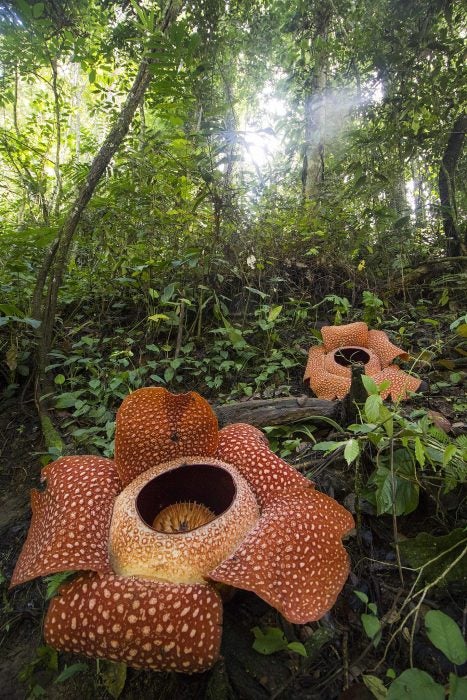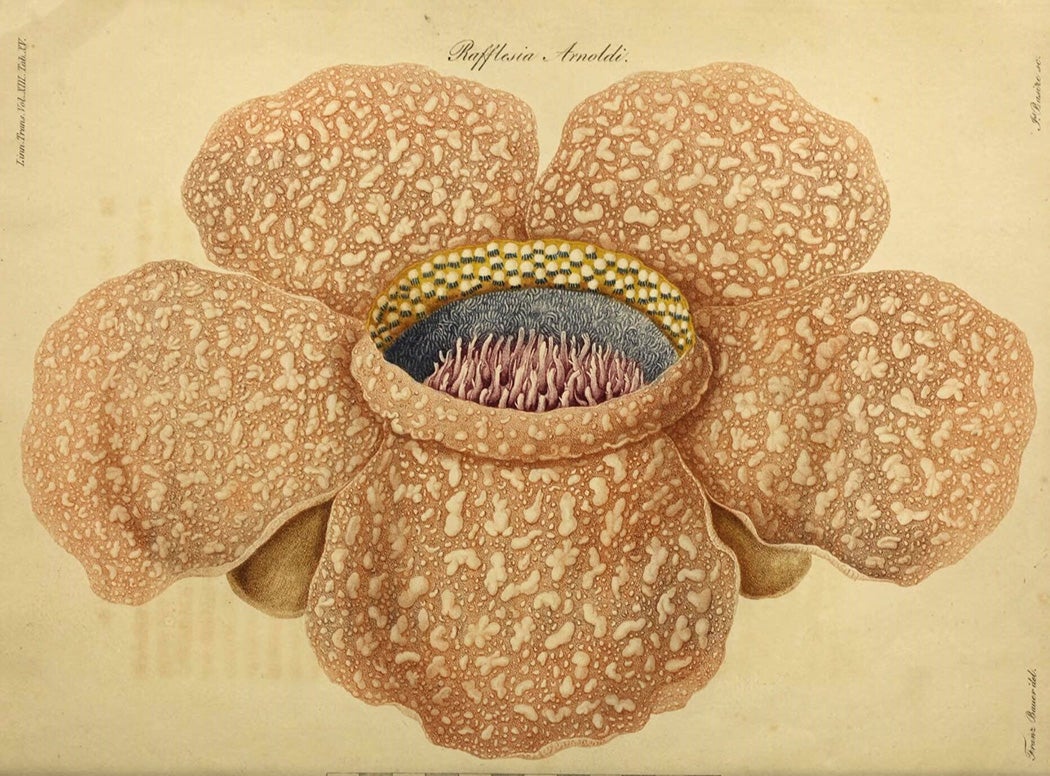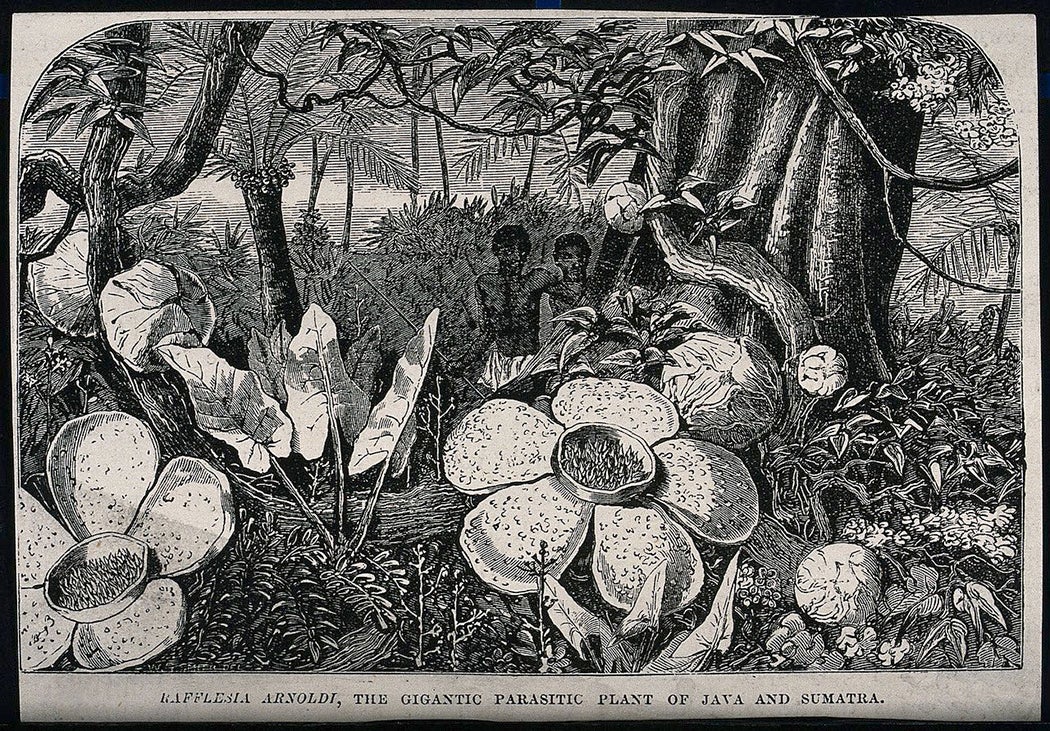Lacking any trace of roots, shoots, stems, or leaves, the parasitic genus Rafflesia, composed of some thirty species scattered throughout Southeast Asia, boasts the largest flowers of any plant in the world. Sometimes referred to as the “corpse lily” or “corpse flower,” the mature flowers emit a putrid odor to attract their main pollinator: carrion flies. Specimens of one species, Rafflesia arnoldii, often exceed three feet in diameter and can weigh more than twenty pounds. The exceptional blossom has even prompted some researchers to question if the plant should be considered an angiosperm (flowering, seed-bearing plant) at all.
These behemoths of the plant kingdom are often confused with another massive, reeking “corpse flower,” titan arum, whose show-stopping inflorescence (actually thousands of tiny flowers) is grown in many Western greenhouses. Artificial Rafflesia cultivation, however, has proven notoriously difficult even for pioneering native botanists like Sofi Mursidawati at the Bogor Botanical Gardens on the island of Java, and thus far impossible for her Western counterparts.
The survival of Rafflesia relies on an exclusive parasitic relationship with the genus Tetrastigma, a woody vine in the grape family. This matter is further complicated by the plant’s finicky reproductive cycle, which involves many months or even years of dormancy. Rafflesia begin life as delicate tendrils of tissue weaving through the vine like a fungus, sometimes only a single cell wide and up to ten meters long. When conditions are right, a pale cabbage-like structure begins to form on the host. After several months, it bursts into a magnificent mottled red and white blossom that remains open for less than a week, before collapsing into a decaying mass. Habitat destruction has also isolated many populations, making it exceedingly unlikely that both male (pollen-producing) and female (pollen-receiving) Rafflesia flowers will bloom close enough to achieve pollination.

Initial European contact with Rafflesia is attributed to French naturalist Louis Auguste Deschamps (1765–1842), who visited Java between 1791 and 1794. His scientific notes and illustrations were seized by the British during an attempt to return to Europe in 1798 and did not resurface until 1861. However, Rafflesia was “rediscovered” by Western science in 1818, when British naturalist Joseph Arnold (1782–1818) traveled to Bengkulu, Sumatra. Arnold died of malaria soon after relaying his account of the plant to Stamford Raffles (1781–1826), the British founder of colonial Singapore. Two years later, the Scottish botanist Robert Brown (1773–1858), eager to claim a British name for the plant, hastily published the first scientific account of Rafflesia arnoldii (named for both Raffles and Arnold) in the Transactions of the Linnaean Society.

Evidenced by these early European encounters, Indigenous knowledge of Rafflesia has been rarely acknowledged yet remains vitally important for all botanists who seek to better understand this arresting rarity of the natural world. Contemporary studies, conducted internationally, continue to rely heavily on the expertise of Native scientists, guides, and park rangers to access isolated Rafflesia populations, which can persist in one spot for several growing seasons before disappearing completely.

Recent research has delved beyond the unusual morphology of Rafflesia, deciphering its equally enigmatic evolutionary history. Studies of the Rafflesiaceae family have revealed an incredible case of horizontal gene transfer (HGT), in which the parasitic plant “steals” genes from its host, typically through their mitochondria. Researchers estimate that at least 1.2 percent of genes in some Rafflesiaceae come from past and present host species, perhaps as a means to bypass their host’s defenses undetected. This “molecular fossil record” of ancient parasite/host interactions, hidden within a massive genome composed mostly of repetitive “junk DNA,” has the potential to significantly advance our understanding of gigantism and parasitism in countless other plant species. However, as most Rafflesia species remain impossible to grow artificially, much of this valuable ecological history may soon be forever lost as Rafflesia disappear alongside their rapidly shrinking habitats.
Charismatic megaflora like the corpse lily and titan arum remain a conservation priority and source of national pride in Indonesia, Malaysia, and several other Southeast Asian countries home to significant “corpse flower” populations. While sometimes consumed as a delicacy in Thailand, Rafflesia flowers are brewed into tea by Indigenous peoples of northern Borneo as a postpartum anti-bacterial agent. Their medicinal properties are still being investigated today.
Furthermore, the formidable size and relative scarcity of these record-breaking flowers have made them a focus of the ecotourism industry. Currently defined by The International Ecotourism Society as “responsible travel to natural areas that conserves the environment, sustains the well-being of the local people, and involves interpretation and education,” ecotourism has been a boon for developing economies in Southeast Asia. A practical conservation solution in theory, ecotourism presents a much more complex reality in practice.
Weekly Newsletter
As global tourism, brought to a standstill by the COVID-19 pandemic, grinds back to full force, it’s critical to consider the impact of this sudden influx of people into protected areas that have spent the past two years mostly free from human intervention. While ecotourism brings in much-needed revenue to local governments, park rangers, and guides, it can also threaten to overwhelm the habitats and species these entities are desperately trying to defend. For many foreign tourists, the curious thrill of the world’s largest flower is too good to pass up, and travel services are eager to meet demand. Carefully considering responsible approaches to the post-pandemic travel resurgence will be vital to preserving existing Rafflesia populations (and their economic benefits) for future generations of locals and tourists alike.
Rafflesia conservation efforts highlight large-scale habitat preservation as essential to safeguarding global plant biodiversity. Additionally, the corpse lily serves as an important case study for the trade-offs that must be considered to promote a more sustainable ecotourism industry in post-pandemic developing economies. The Dumbarton Oaks Plant Humanities Initiative seeks to address these urgent conservation issues—and many more—in part by exploring the deep entanglement of extraordinary plants like Rafflesia with human cultures past, present, and future.







